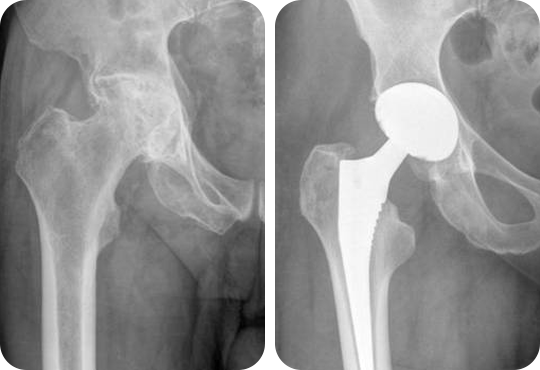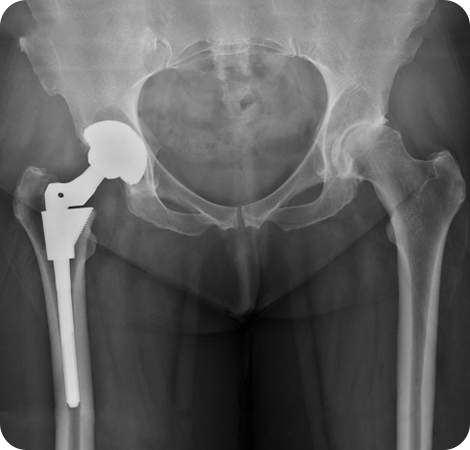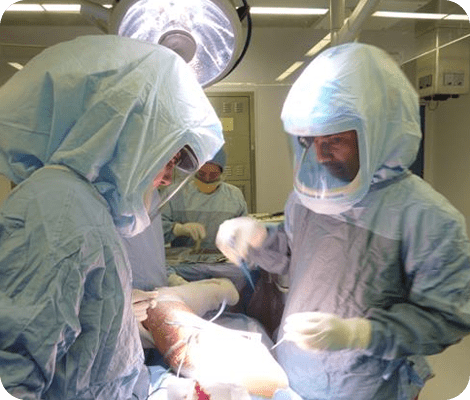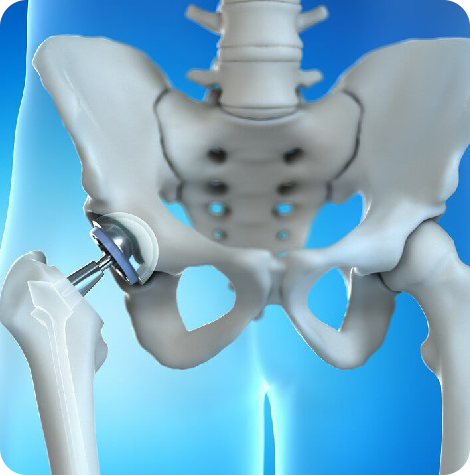 Hip pain associated with weight bearing, limiting activities of daily living.
Hip pain associated with weight bearing, limiting activities of daily living. Rest pain.
Rest pain. Stiffness in a hip limiting your ability to move or lift your leg.
Stiffness in a hip limiting your ability to move or lift your leg. Little pain relief from pain killers and anti-inflammatory drugs or glucosamine.
Little pain relief from pain killers and anti-inflammatory drugs or glucosamine. Harmful or unpleasant side effects from pain medications.
Harmful or unpleasant side effects from pain medications. Other treatments such as physical therapy or the use of a gait aid such as a walking stick don't relieve hip pain
Other treatments such as physical therapy or the use of a gait aid such as a walking stick don't relieve hip pain

A variety of designs and materials are currently used in artificial hip joints, but all consist of two primary components: the ball (femoral head), made of a highly polished, durable metal or ceramic, and the socket (acetabular component), which is a robust cup made from plastic, ceramic, or metal—often housed within an outer metal shell. To secure the implant, special surgical cement may be used to fill the space between the prosthesis and the natural bone. Alternatively, uncemented prostheses are commonly used, particularly in younger, more active patients with good bone quality. These implants often feature a textured metal surface or a special bone-like coating that encourages natural bone growth into the implant for long-term fixation. In some cases, a hybrid approach may be used—for example, a cemented femoral component combined with an uncemented socket. Your orthopaedic surgeon will select the type of prosthesis most appropriate for your individual needs and bone condition.

Following surgery, you will be taken to the recovery room, where you will be closely monitored for one to two hours as you recover from anaesthesia. Once stable, you will be transferred back to the ward. As your condition allows, you will be assisted with gentle mobilisation around the bed. Later that day or the following morning, a physiotherapist will guide you through supervised stair practice. You will be discharged once your overall condition is stable and your mobility is deemed adequate. The pace of post-operative recovery varies from person to person, but most patients are able to walk short distances without assistance by around four weeks after surgery. Recovery times are often shorter when modern techniques such as Short-Stay Joint Replacement or Minimally Invasive Surgery are used.

In recent years, orthopaedic surgeons have developed advanced surgical techniques for total hip replacement that use smaller incisions and aim to minimize muscle damage. These minimally invasive approaches are designed to promote quicker, less painful recovery, earlier return to daily activities, and improved cosmetic outcomes. Minimally invasive and small-incision total hip replacement is a rapidly evolving field. While some techniques have demonstrated safety and effectiveness, others may carry a higher risk of complications if not performed in appropriately selected patients. Among the established methods, the single mini-incision posterior approach has shown promising results in suitable candidates, offering improved pain relief, faster rehabilitation, better cosmetic appearance, and enhanced overall patient experience—without a significant increase in complications. The National Institute for Health and Care Excellence (NICE) has issued updated guidance on the use of minimally invasive techniques in hip replacement surgery.

You will usually stay in the hospital for about 2 days. You will be given routine pain medication, and most patients feel little pain after surgery. Walking and light activity are important to your recovery and will begin soon after your surgery. The physiotherapist will teach you specific exercises to strengthen your hip and restore movement for walking and other normal daily activities.

The complication rate following hip replacement surgery is low. Serious complications, such as joint infection, occur in less than 2 percent of patients. Blood clots in the leg veins or pelvis are the most common complication of hip replacement surgery. Routine measures including blood thinning medication is administered in all patients, often extended for a few days after surgery. Other measures may include special stockings, inflatable leg coverings and ankle pump exercises. These measures help to prevent blood clots from forming in your leg veins or becoming symptomatic. Leg-length inequality may occur or may become or seem worse after a hip replacement. Some hip conditions are associated with marked leg shortening due to bone loss/deformity around the hip. With careful pre-operative planning and attention to detail, it is often possible to achieve leg length equality following surgery. This will be taken into account, in addition to other issues, such as the stability and biomechanics of the hip in most cases. Other complications such as dislocation, nerve and blood vessel injury, bleeding, fracture and stiffness can occur. In a small number of patients, some pain can continue, or new pain can occur after surgery. Over years, the hip prosthesis may wear out or loosen. This problem will likely be less common with newer materials and techniques.

Most people who undergo hip replacement surgery experience a dramatic reduction of hip pain and a significant improvement in their ability to perform the common activities of daily living. However, hip replacement surgery will not enable you to do more than you could before your hip problem developed. Following surgery, you may be asked to avoid specific positions of the joint that could lead to dislocation. Even with normal use and activities, an artificial joint (prosthesis) develops some wear over time. If you participate in high-impact activities or are overweight, this wear may accelerate and cause the prosthesis to loosen The patient information and guidelines provided by National Institute of Clinical Excellence (NICE) can be viewed on this link

Prof Kavarthapu's scientific article on the technique of minimally invasive hip surgery can be accessed here: https://link.springer.com/chapter/10.1007/978-981-99-5517-6_9